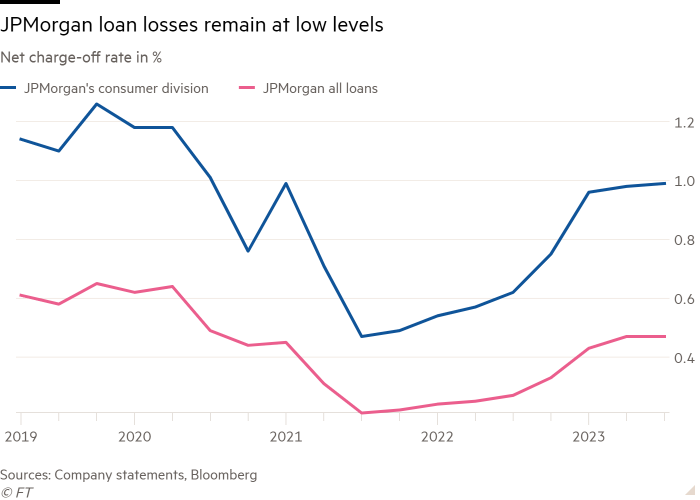Unlock the Editor’s Digest for free
Roula Khalaf, Editor of the FT, selects her favourite stories in this weekly newsletter.
JPMorgan Chase reported a 35 per cent jump in profits for the third quarter, as the biggest US bank continues to reap the benefits from higher interest rates and lower than normal loan losses.
The bank said on Friday that net income climbed to $13.2bn, from $9.7bn a year earlier. That was better than the $11.9bn analysts had expected, according to data compiled by Bloomberg.
JPMorgan’s chief executive Jamie Dimon said the earnings were “solid” but acknowledged that “these results benefit from our over-earning on both net interest income and below normal credit costs, both of which will normalise over time”.
In a warning about the conflicts in Ukraine and Israel, Dimon said this “may be the most dangerous time the world has seen in decades”. Dimon’s views on world affairs are closely followed across Wall Street.
JPMorgan’s shares trimmed an early gain of more than 4 per cent to close 1.5 per cent higher in New York.
As with the previous quarter, much of the gain was driven by net interest income, which at $22.7bn was 30 per cent higher than the same quarter a year ago. The figure was ahead of analysts’ expectations of $22.4bn, as JPMorgan continued to gain from the Federal Reserve’s cycle of interest rate rises and the bank’s emergency acquisition of First Republic.

JPMorgan raised its net interest income target for 2023, excluding its trading division, from about $87bn to about $89bn.
Net interest income is the difference between what banks pay on deposits and what they earn from loans and other assets. Big banks such as JPMorgan have been able to charge more for loans over the past 18 months without offering savers significantly higher rates for deposits.
In a further boost to profits, JPMorgan released $113mn in reserves it had previously set aside for potential losses, confounding analysts’ estimates for the bank to add roughly another $850mn to its reserves.
JPMorgan continued to benefit from relatively low losses on its loans in the quarter. Net charge-offs — the portion of loans with losses that are marked as unrecoverable — totalled $1.5bn, more than double the same quarter a year ago but only up 6 per cent from the second quarter.

On an annualised basis, JPMorgan wrote off 47 cents for every $100 it had loaned out, net of any recoveries it made.
Loan losses have been at historically low levels since the early months of the Covid-19 pandemic thanks to government stimulus programmes. But although the Fed’s run of interest rate increases has boosted the profits JPMorgan has made from making loans, there are worries that higher interest rates will pile pressure on borrowers.
In a sign of the better than expected credit environment for US consumers, JPMorgan cut its outlook for the net charge-off rate at its card services business from 2.6 per cent to about 2.5 per cent.
It also trimmed its guidance for full-year expenses from roughly $84.5bn to about $84bn.
JPMorgan reported investment banking fees of $1.7bn, down 3 per cent from a year earlier but beating analysts’ estimates of $1.6bn.
JPMorgan, an industry bellwether, is reporting earnings along with Citigroup and Wells Fargo. Bank of America and Goldman Sachs report results on Tuesday, while Morgan Stanley reports on Wednesday.







